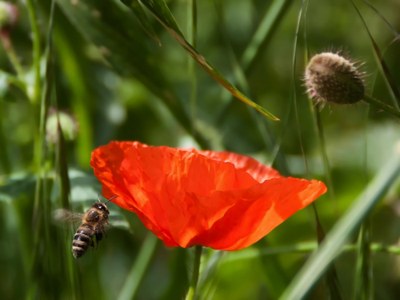The extinction of the bees – a multifunctional phenomenon
Lisa Höhne
Bees achieve a pollinating activity of about 80%. That is why they are playing one of the most important roles in our global ecosystem. Their primary responsibility is the spreading of pollen for the majority of plant species and as a result they also help to provide basic food resources for herbivores. Therefore, they contribute to a balanced and stable ecosystem (Dommel et.al. 2017).
But in the last few years this balance turned into an increasing imbalance. Thousands of bees are dying every year and therefore the so called ‘colony collapse disorder’ is getting attention from the media (von Heyden-Klaaßen & Scharge 2016). But there is not just one main reason for this process. It is a multifunctional phenomenon mainly caused by different environmental factors which will lead to so far unknown mutual reactions. Examples for such factors are diseases and pests - like the Varroa mite - industrial farming especially because of the use of pesticides, or environmental pollution. All that leads to the collapse of many bee colonies (Hainbuch 2014).
Unfortunately, until today the awareness of the public for this problem of mass extinction is not, or just barely existing although there are some case studies which investigate and verify this process already (Dommel et.al. 2017).
The aim of this Bachelor thesis is to give an overview on this far-reaching phenomenon with a particular focus on the reasons that cause the collapse and to have a closer look at the possible implications of this tragic development. In order to do so I will conduct a literature review as well as interviews with beekepers for a case study in the Havelland area.

References:
Dommel, Michael et.al. (2017): Wo sind all die Bienen hin? – Warum weltweit die Bienenpopulationen sterben. (Ed.): NABU – Naturschutzbund Deutschland e.V.. URL: https://www.nabu.de/tiere-und-pflanzen/insekten-und-spinnen/hautfluegler/bienen/13676.html - last access: 31.12.2017
Hainbuch, Friedrich (2014): Das lautlose Sterben der Bienen – Ursachen-Konsequenzen-Auswege. Magdeburg: VerlagsKGWolf. p15
Von Heyden-Klaaßen, Renate & Scharge, Klaus-Dieter (2016): Bienensterben.(Ed.): ETN e.V..URL: http://etnev.de/tierschutz/naturschutz/bienensterben?gclid=EAIaIQobChMI1J3i9p-J1wIVY7XtCh1wCgi-EAAYASAAEgL_z_D_BwE – last access: 31.12.2017
